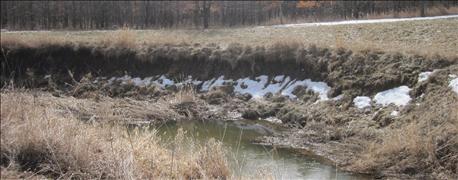
What do you picture when you hear the term “two-stage-ditch”? You may figure a lot of bulldozer work, and tons of soil being moved from place to place. Perhaps these photos will convince you that constructing a two-stage ditch is worth every bit of effort and expense.

NEEDS HELP: A typical stream bank has nowhere for sediment and nutrient particles to settle out.
Kris Vance, public relations coordinator for the Natural Resources Conservation Service in Indiana, says these before-and-after pictures represent a real transformation of a ditch in Kosciusko County. Before the two-stage ditch was constructed, a typical ditch with normal banks provided little if any room for sediment to settle before entering the stream itself. Sediment, the No. 1 pollutant of streams, often carries nutrient and chemical particles along with it.
What the two-stage ditch does, Vance notes, is provide a “shelf” where water can collect before it takes the next step and moves into the stream. While water pools on the vegetation-covered shelf, sediment can settle out. Nutrients and pesticides attached to soil particles settle out with the particles. The result is that when water finally enters the stream, a high percentage of the sediment and nutrient and pesticide particles are left behind. They don’t make it into the stream.
Ditch details
This particular two-stage ditch was recently installed. It is an extension of a two-stage ditch originally installed by The Nature Conservancy in Kosciusko County in 2010. The original two-stage ditch was approximately 1,200 feet long.
Some 2,600 feet, or roughly a half-mile, of two-stage ditch was added in this current project, Vance notes. That means the entire two-stage ditch is now 3,800 feet, or roughly three-quarters of a mile, long.
Cost-share through the NRCS Environmental Quality Incentives Program helped defray expenses to the landowner for installation of the two-stage ditch. If you are interested in more details, contact your local NRCS office.
BEFORE: There is nowhere for nutrients to settle out before entering the stream in this typical ditch. AFTER: After its transformation, the ditch’s shape includes a bench where sediment and nutrients can settle out before entering the stream.
About the Author(s)
You May Also Like




